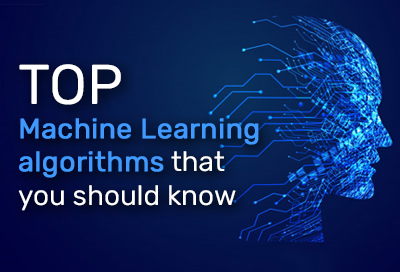
From basic everyday functions of making computers smarter, Machine Learning algorithms assist computerize manual tasks for making our lives easy. The noteworthiness of Machine Learning has developed much further, which is the reason enthusiastic data researchers and engineers look forward to learning various strategies to sharpen their skills.
In these profoundly dynamic times, there are many machine learning algorithms created to solve complex genuine issues. These algorithms are exceptionally mechanized and self-modifying as they keep on improving over with the addition of an expanding amount of data and with less human intervention required. The following are the best 10 Machine Learning algorithms that you should know. These will assist you in making practical projects, regardless of whether you pick the Supervised, Unsupervised, or Reinforcement Machine Learning model.
1. Linear Regression Algorithm
LRA (Linear Regression algorithm) decides the connection between an independent variable and a dependent variable. It helps comprehends the impact that the independent variable will cause on the dependent variable if the previous' worth is changed. The independent variable is likewise alluded to as the informative variable, while the dependent variable is named as the factor of interest.
2. Random Forest Algorithm
The Random Forest algorithm works by grouping diverse choice trees depending on their attributes. This model can manage a portion of the normal constraints of the Decision Tree algorithm. It can also be more exact to foresee the result when the quantity of choices goes higher. The choice trees are mapped here depends on the CART or Classification and Regression Trees model.
3. Logistic Regression Algorithm
Logistic Regression algorithm assists calculate separate binary values from a bunch of independent variables. It’s at that point assists to forecast the probability of a result by investigating the data against a logit function. Including interaction terms, eliminating properties, standardizing techniques, and utilizing a non-linear model can also be utilized to create better logistic regression models.
4. Decision Free Algorithm
The Decision Tree algorithm is the most well-known Machine Learning algorithms out there today. The model works by categorizing issues for both categories as well as constant dependent variables. Here, all the possible results are partitioned into various normalized sets with the most significant independent variables utilizing a tree-branching methodology.
5. K-means Algorithm
K-Means algorithm is ordinarily utilized for solving clustering issues. It takes datasets into a particular number of clusters, which is alluded to as “K”. The data are arranged in such a way that all the data points in the group stay homogenous. Simultaneously, the data point in one group will be varied from the data assembled in other groups.
6. Apriori Algorithm
Apriori algorithm is a sort of machine learning algorithm, which makes affiliation rules dependent on a pre-characterized dataset. The rules are in the IF_THEN format, which implies that if action A happens at that point action B will probably happen also. The algorithm determines such conclusions by examining the proportion of action B to action A.
7. Classification Algorithm
Classification algorithms are like clustering algorithms, yet while grouping algorithms are utilized to both discover the classifications in data and sort information focuses into those classifications, Classification algorithms sort data into predefined categories.
8. Naive Bayes Classifier Algorithm
The Naive Bayes Classifier algorithm works by assuming that particular property in classification isn't identified by other properties of the group. This assists the algorithm to consider all the highlights independently as it computes the result. It is effortless to create a Naive Bayes model for spacious datasets, and can even improve huge numbers of the complex classification strategies.
9. KNN (K-Nearest Neighbors Algorithm)
The K-Nearest Neighbors algorithm utilizes the whole data set as the preparation set, rather than splitting the data set into a preparation set and test set. At the point when a result is needed for a new data instance, the KNN calculation goes through the whole data set to discover the k-nearest instances to the new instance.
10. Support Vector Machine Algorithm
Support Vector Machine algorithm is utilized to specify data as points in a huge n-dimensional plane. Here, "n" alludes to the number of properties in hand, every one of which is connected to a particular subset to arrange the data. Typical utilization of the Support Vector Machine algorithm can be found in the regression of issues. It works by arranging data into various levels utilizing a specific line or hyper-plane.
The above-mentioned Machine Learning algorithms will assist you in beginning with your ideal projects right away. These will prepare you for understanding the extent of Machine Learning as well as work out complex issues all the more without any problem.